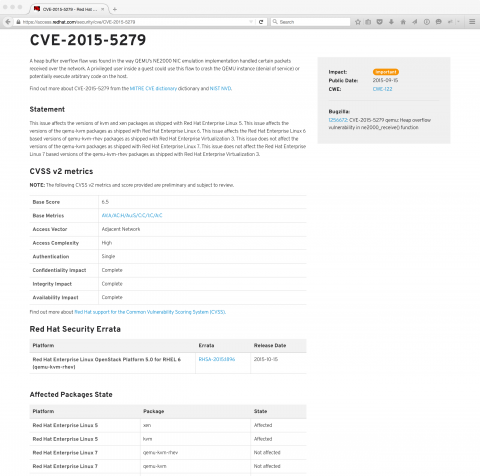Red Hat CVE Database Revamp
Since 2009, Red Hat has provided details of vulnerabilities with CVE names as part of our mission to provide as much information around vulnerabilities that affect Red Hat products as possible. These CVE pages distill information from a variety of sources to provide an overview of each flaw, including information like a description of the flaw, CVSSv2 scores, impact, public dates, and any corresponding errata that corrected the flaw in Red Hat products.
Over time this has grown to include more information, such as CWE identifiers, statements, and links to external resources that note the flaw (such as upstream advisories, etc.). We’re pleased to note that the CVE pages have been improved yet again to provide even more information.
Beyond just a UI refresh, and deeper integration into the Red Hat Customer Portal, the CVE pages now also display specific “mitigation” information on flaws where such information is provided. This is an area where we highlight certain steps that can be taken to prevent the exploitability of a flaw without requiring a package update. Obviously this is not applicable to all flaws, so it is noted only where it is relevant.
In addition, the CVE pages now display the “affectedness” of certain products in relation to these flaws. For instance, in the past, you would know that an issue affected a certain product either by seeing that an erratum was available (as noted on the CVE page) or by visiting Bugzilla and trying to sort through comments and other metadata that is not easily consumable. The CVE pages now display this information directly on the page so it is no longer required that a visitor spend time poking around in Bugzilla to see if something they are interested in is affected (but has not yet had an erratum released).
To further explain how this works, the pages will not show products that would not be affected by the flaw. For instance, a flaw against the mutt email client would not note that JBoss EAP is unaffected because EAP does not ship, and has never shipped, the mutt email client. However, if a flaw affected mutt on Red Hat Enterprise Linux 6, but not Red Hat Enterprise Linux 5 or 7, the CVE page might show an erratum for Red Hat Enterprise Linux 6 and show that mutt on Red Hat Enterprise Linux 5 and 7 is unaffected. Previously, this may have been noted as part of a statement on the page, but that was by no means guaranteed. You would have to look in Bugzilla to see if any comments or metadata noted this; now it is quite plainly noted on the pages directly.
This section of the page, entitled “Affected Packages State”, is a table that lists the affected platform, package, and a state. This state can be:
“Affected”: this package is affected by this flaw on this platform
“Not affected”: this package, which ships on this platform, is not affected by this flaw
“Fix deferred”: this package is affected by this flaw on this platform, and may be fixed in the future
“Under investigation”: it is currently unknown whether or not this flaw affects this package on this platform, and it is under investigation
“Will not fix”: this package is affected by this flaw on this platform, but there is currently no intention to fix it (this would primarily be for flaws that are of Low or Moderate impact that pose no significant risk to customers)
For instance, the page for CVE-2015-5279 would look like this, noting the above affected states:
By being explicit about the state of packages on the CVE pages, visitors will know exactly what is affected by this CVE, without having to jump through hoops and spend time digging into Bugzilla comments.
Other improvements that come with the recent changes include enhanced searching capabilities. You can now search for CVEs by keyword, so searching for all vulnerabilities that mention “openssl” or “bind” or “XSS” are now possible. In addition, you can filter by year and impact rating.
The Red Hat CVE pages are a primary source of vulnerability information for many, a gateway of sorts that collects the most important information that visitors are often interested in, with links to further sources of information that are of interest to the vulnerability researcher.
Red Hat continues to look for ways to provide extra value to our customers. These enhancements and changes are designed to make your jobs easier, and we believe that they will become an even greater resource for our customers and visitors. We hope you agree!



Comments